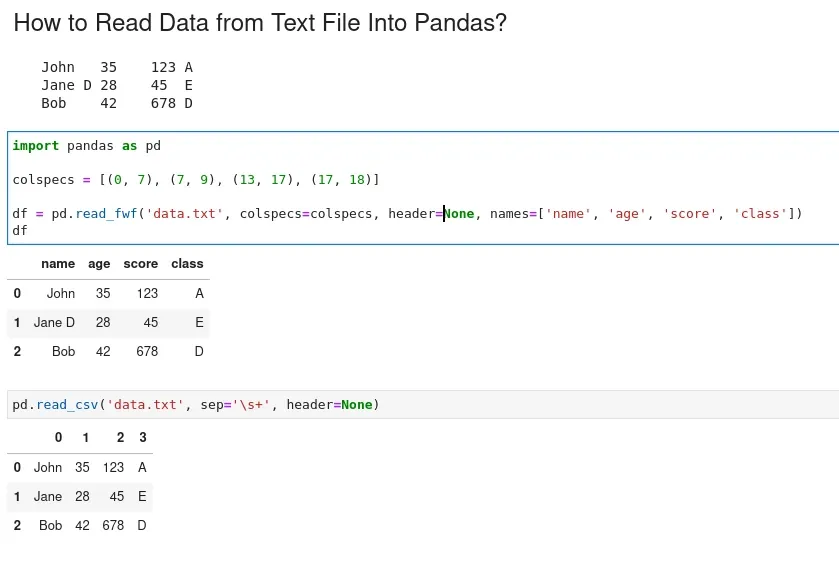The following step-by-step example shows how to load data from a text file into Pandas. We can use:
read_csv()function- it handles various delimiters, including commas, tabs, and spaces
pd.read_fwf()- read fixed-width formatted lines into DataFrame
Let's cover both cases into examples:
read_csv - delimited file
To read a text into Pandas DataFrame we can use method read_csv() and provide the separator:
import pandas as pd
df = pd.read_csv('data.txt', sep=',')
Where sep argument specifies the separator. Separator can be continuous - '\s+'.
Other useful parameters are:
header=None- does the file contain headersnames=["a", "b", "c"]- the column namesskiprows=[0,1]- skip rowsindex_col=True- use index from the file
read_fwf - fixed-width file
To read data from a fixed-width file in Pandas we can use read_fwf. Suppose we have a file 'data.txt' like:
John 35 123 A
Jane D 28 45 E
Bob 42 678 D
We can see that columns are aligned by position rather than separated by delimiters. Since the columns are separated by fixed widths:
- first column - 7 chars
- (0, 7)
- second - 2 chars
- (7, 9)
we can't use read_csv() with a separator. Instead we will:
- specify the column widths
- read the fixed-width file into a DataFrame
import pandas as pd
colspecs = [(0, 7), (7, 9), (13, 17), (17, 18)]
df = pd.read_fwf('data.txt', colspecs=colspecs, header=None, names=['name', 'age', 'score', 'class'])
df
The result is:
| name | age | score | class | |
|---|---|---|---|---|
| 0 | John | 35 | 123 | A |
| 1 | Jane D | 28 | 45 | E |
| 2 | Bob | 42 | 678 | D |

Pandas read text file line by line
To read a text file line by line into a pandas DataFrame we can:
- create an empty DataFrame
- create an iterator to read the file line by line
- iterate over the iterator and append each line to the DataFrame
- reset the index of the DataFrame
import pandas as pd
df = pd.DataFrame()
iterator = pd.read_csv('data.txt', header=None, iterator=True, chunksize=1)
for chunk in iterator:
df = df.append(chunk)
df = df.reset_index(drop=True)
Pandas read text file with pattern
As an alternative we can use list comprehension to read files and filter it.
Let's work with the following file:
John 35 123 A
Pattern
Jane D 28 45 E
Bob 42 678 D
End of pattern
We can find the numbers of the start and end lines by matching pattern:
a=[]
with open('data.txt',"r") as r:
a=r.readlines()
a=[x.replace("\n","") for x in a]
start = a.index("Pattern") +1
end = a.index("End of pattern")
start, end
After that we can read the file with read_fwf or read_csv and filter the lines:
import pandas as pd
df = pd.read_fwf('data.txt', colspecs=colspecs, header=None, names=['name', 'age', 'score', 'class'])
df = df[start:end]
Which give us:
| name | age | score | class | |
|---|---|---|---|---|
| 2 | Jane D | 28 | 45 | E |
| 3 | Bob | 42 | 678 | D |
Summary
We've seen three different ways of reading and loading text file into Pandas DataFrame. We covered how to read delimited or fixed-length files with Pandas.
We also saw how to read text files line by line and how to filter csv or text file by pattern.









